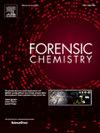Differentiated factor expression by chemical class in the concentration of ignitable liquid residue by dynamic vapor microextraction
IF 2.6
3区 医学
Q2 CHEMISTRY, ANALYTICAL
引用次数: 0
Abstract
Ignitable liquids (IL) are complex mixtures whose chromatographic profiles may vary considerably across chemical compound classes. Dynamic vapor microextraction (DVME) is an emerging technique with potential application for extracting and concentrating IL from fire debris. A previous study assessed the effects of 11 instrumental and debris factors on DVME performance by collecting chromatographic data from a designed experiment, but did not investigate whether factor effects had differential expression within individual chemical classes. In this study, that experimental data is reanalyzed to assess factor effects individually in each of five chemical classes relevant to IL identification (alkanes, cycloalkanes & alkenes, aromatic-alkylbenzenes, indanes, and polynuclear aromatics), and effects are compared to the results previously reported from the original analysis. Two new instrument settings (capillary vapor trap coating and temperature) are found to have significant class-specific effects, providing additional avenues of improving DVME performance, while the effect of collection volume is found to be discordant in one class (alkane) compared to all others. Effects from uncontrollable debris factors on DVME performance are also found to be partially mitigated in certain classes through optimal instrument settings, though “optimal” may depend on the sample being analyzed. This analysis offers new insight into DVME optimization and robustness, and provides a discussion on how experimental conclusions drawn from aggregate chromatographic data, without consideration of class-specific effects, may be incomplete.

动态蒸气微萃取可燃液渣浓度中化学类分化因子的表达
可燃液体(IL)是一种复杂的混合物,其色谱谱在不同的化合物类别中可能有很大的不同。动态蒸汽微萃取(DVME)是一种新兴的技术,在从火灾残骸中提取和浓缩IL方面具有潜在的应用前景。先前的一项研究通过收集设计实验的色谱数据,评估了11种仪器和碎屑因素对DVME性能的影响,但没有研究因素影响在单个化学类别中是否有差异表达。在本研究中,实验数据被重新分析,以评估与IL鉴定相关的五种化学类别(烷烃,环烷烃和;烯烃,芳烃-烷基苯,吲哚和多核芳烃),并与先前报告的原始分析结果进行了比较。两种新的仪器设置(毛细管蒸汽疏水阀涂层和温度)被发现具有显著的类别特定影响,为提高DVME性能提供了额外的途径,而发现收集量的影响在一个类别(烷烃)中与所有其他类别相比是不一致的。不可控碎片因素对DVME性能的影响也被发现在某些类别中,通过优化仪器设置可以部分减轻,尽管“最佳”可能取决于所分析的样品。该分析为DVME优化和稳健性提供了新的见解,并讨论了在不考虑类别特定效应的情况下,从总体色谱数据得出的实验结论可能是不完整的。
本文章由计算机程序翻译,如有差异,请以英文原文为准。
求助全文
约1分钟内获得全文
求助全文
来源期刊

Forensic Chemistry
CHEMISTRY, ANALYTICAL-
CiteScore
5.70
自引率
14.80%
发文量
65
审稿时长
46 days
期刊介绍:
Forensic Chemistry publishes high quality manuscripts focusing on the theory, research and application of any chemical science to forensic analysis. The scope of the journal includes fundamental advancements that result in a better understanding of the evidentiary significance derived from the physical and chemical analysis of materials. The scope of Forensic Chemistry will also include the application and or development of any molecular and atomic spectrochemical technique, electrochemical techniques, sensors, surface characterization techniques, mass spectrometry, nuclear magnetic resonance, chemometrics and statistics, and separation sciences (e.g. chromatography) that provide insight into the forensic analysis of materials. Evidential topics of interest to the journal include, but are not limited to, fingerprint analysis, drug analysis, ignitable liquid residue analysis, explosives detection and analysis, the characterization and comparison of trace evidence (glass, fibers, paints and polymers, tapes, soils and other materials), ink and paper analysis, gunshot residue analysis, synthetic pathways for drugs, toxicology and the analysis and chemistry associated with the components of fingermarks. The journal is particularly interested in receiving manuscripts that report advances in the forensic interpretation of chemical evidence. Technology Readiness Level: When submitting an article to Forensic Chemistry, all authors will be asked to self-assign a Technology Readiness Level (TRL) to their article. The purpose of the TRL system is to help readers understand the level of maturity of an idea or method, to help track the evolution of readiness of a given technique or method, and to help filter published articles by the expected ease of implementation in an operation setting within a crime lab.
 求助内容:
求助内容: 应助结果提醒方式:
应助结果提醒方式:


